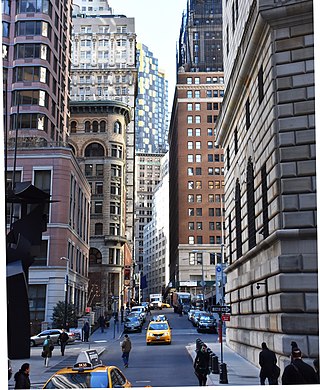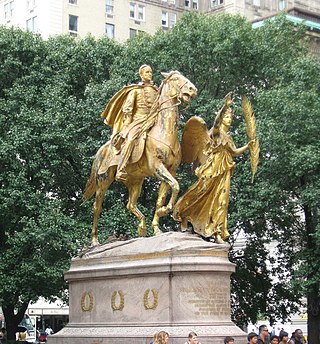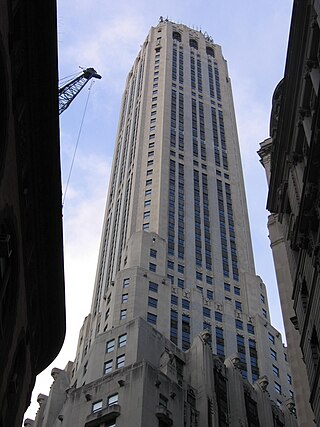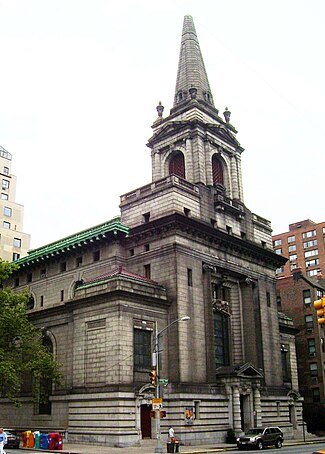
Carrère and Hastings, the firm of John Merven Carrère and Thomas Hastings, was one of the outstanding American Beaux-Arts architecture firms. Located in New York City, the firm practiced from 1885 until 1929, although Carrère died in an automobile accident in 1911.

St. Bartholomew's Church, commonly called St. Bart's, is a historic Episcopal parish founded in January 1835, and located on the east side of Park Avenue between 50th and 51st Street in Midtown Manhattan, in New York City. In 2018, the church celebrated the centennial of its first service in its Park Avenue home.

Augusta Emma Stetson was an American religious leader. Known for her impressive oratory skills and magnetic personality, she attracted a large following in New York City. However, her increasingly radical theories, conflicts with other church members including a well-known rivalry with Laura Lathrop, and attempts to supplant Mary Baker Eddy as the leader of The First Church of Christ, Scientist, led to her eventually being excommunicated from the church on charges of insubordination and of false teaching. Afterwards she began preaching and publishing various works on her theories which she named the "Church Triumphant," and started a controversial radio station to advance her cause.

St. Michael's Church is a historic Episcopal church at 225 West 99th Street and Amsterdam Avenue on Manhattan's Upper West Side in New York City. The parish was founded on the present site in January 1807, at that time in the rural Bloomingdale District. The present limestone Romanesque building, the third on the site, was built in 1890–91 to designs by Robert W. Gibson and added to the National Register of Historic Places in 1996.

The Church of Saint Mary the Virgin is an Episcopal Anglo-Catholic church in Midtown Manhattan, New York City, which is part of the Episcopal Diocese of New York of the Episcopal Church in the United States of America. The church complex is located in the heart of Times Square at 133-145 West 46th Street, with other buildings of the complex at 136-144 West 47th Street, between Sixth and Seventh Avenues. It is colloquially known as "Smoky Mary's" because of the amount of incense used in the services.

96th Street is a major two-way street on the Upper East Side and Upper West Side sections of the New York City borough of Manhattan. It runs in two major sections: between the FDR Drive and Fifth Avenue on the Upper East Side, and between Central Park West and Henry Hudson Parkway on the Upper West Side. The two segments are connected by the 97th Street transverse across Central Park, which links the disconnected segments of 96th and 97th Streets on each side.

Congregation Shaare Zedek is a Conservative synagogue located on West 93rd Street in Manhattan, New York City, New York, in the United States.

The Central Park West Historic District is located along Central Park West, between 61st and 97th Streets, on the Upper West Side of Manhattan in New York City, United States. The district was added to the National Register of Historic Places on November 9, 1982. The district encompasses a portion of the Upper West Side-Central Park West Historic District as designated by the New York City Landmarks Preservation Commission, and contains a number of prominent New York City designated landmarks, including the Dakota, a National Historic Landmark. The buildings date from the late 19th century to the early 1940s and exhibit a variety of architectural styles. The majority of the district's buildings are of neo-Italian Renaissance style, but Art Deco is a popular theme as well.

The Park Avenue Christian Church is a joint Disciples of Christ and United Church of Christ church located at 1010 Park Avenue at 85th Street, on the Upper East Side of Manhattan, in New York City, New York, in the United States. The Rev. Kaji S. Douša has served as Senior Pastor since 2016. She is the first woman and the first Black woman to be called to this role, the second African-American after the Rev. Alvin Jackson, Pastor Emeritus.

William Street is a street in the Financial District of Lower Manhattan, New York City. It runs generally southwest to northeast, crossing Wall Street and terminating at Broad Street and Spruce Street, respectively. Between Beaver Street and Broad Street, the street is known as South William Street. Between Beekman Street and Spruce Street, in front of New York Downtown Hospital, William Street is a pedestrian-only street.

Third Church of Christ, Scientist, established in 1918, is a Christian Science church in downtown Washington, D.C. From 1971 to 2014, the church was located in a controversial building at 16th and I Street NW. Considered a significant work of "Brutalist" church architecture by some critics, the building was considered unsatisfactory by members of the Church's congregation, which shrank over the years. In 2007, the church applied for a demolition permit for the building to permit sale and redevelopment of the site, with plans to relocate to a more suitable structure. A 1991 application for landmark status for the building, filed to forestall a demolition threat then, was subsequently approved. After a lawsuit and hearings, the District of Columbia issued a demolition permit in May 2009, and the building was demolished in 2014. In 2015, Third Church merged with First Church of Christ, Scientist. The congregation continues as First Church and conducts its activities in a portion of the new building.

Our Saviour New York, at 417 West 57th Street between Ninth and Tenth Avenues in the Hell's Kitchen neighborhood of Manhattan, New York City, was built in 1886-87 and was designed by Francis H. Kimball in the Late Victorian Gothic style for the Catholic Apostolic Church, an English group which believed in an imminent Second Coming. In 1995, with the congregation dwindling, the church was donated to the Lutheran Life's Journey Ministries, which in 1997 rededicated it as the Church for All Nations. On April 26, 2015, the Church for All Nations held its last service. Members of the congregation still worship as All Nations Lutheran Church in a rehearsal studio at 244 West 54th Street. The church itself is now, in 2018, Our Saviour New York and is directed by lead pastor Matt Popovits and Mark Budenholzer.

Grand Army Plaza is a square at the southeast corner of Central Park in Manhattan, New York City, at the intersection of Fifth Avenue and Central Park South, covering two blocks on the west side of Fifth Avenue between 58th and 60th Streets. It contains an equestrian statue of William Tecumseh Sherman on its northern half and the Pulitzer Fountain on its southern half.

The former Second Church of Christ, Scientist is a historic Christian Science church building located at Central Park West and West 68th Street on the Upper West Side of Manhattan, New York City, within the Central Park West Historic District. The Beaux-Arts building was designed by architect Frederick R. Comstock and constructed in 1899–1901. The building was restored beginning in 2005 by Sydness Architects which planned to clean the facade, reinforce the stained-glass windows, and waterproof the copper dome and illuminate the skylight.
Sydness Architects is a New York City-based architecture firm founded by K. Jeffries Sydness AIA in 1996. Other senior members of the firm are Associates Matthew M. Ruopoli, AIA and Melissa Carolina Cheing, AIA.

14th Street is a major crosstown street in the New York City borough of Manhattan, traveling between Eleventh Avenue on Manhattan's West Side and Avenue C on Manhattan's East Side. It forms a boundary between several neighborhoods and is sometimes considered the border between Lower Manhattan and Midtown Manhattan.

The Gainsborough Studios, also known as 222 Central Park South, is a residential building on Central Park South, just east of Columbus Circle, in Midtown Manhattan, New York City. Designed by Charles W. Buckham, the building is 16 stories tall with 34 apartments. Named after English painter Thomas Gainsborough, the building is one of several in Manhattan that were built in the early 20th century as both studios and residences for artists.

Exchange Place is a street in the Financial District of Lower Manhattan, New York City. The street runs five blocks between Trinity Place in the west and Hanover Street in the east.
5 Columbus Circle is an office building on the southeast corner of Broadway and 58th Street, just south of Columbus Circle, in the Midtown Manhattan neighborhood of New York City, New York, United States. Designed by Carrère and Hastings in the Beaux-Arts style, it is 286 feet (87 m) tall with 20 stories.

130 West 30th Street, also known as The Cass Gilbert, is a luxury condominium on 30th Street between the Avenue of the Americas and Seventh Avenue in Midtown Manhattan in New York City. The 18-story building was designed by Cass Gilbert in the Assyrian Revival style as offices, showrooms and manufacturing space in the Garment District. The building is a New York City designated landmark.





















